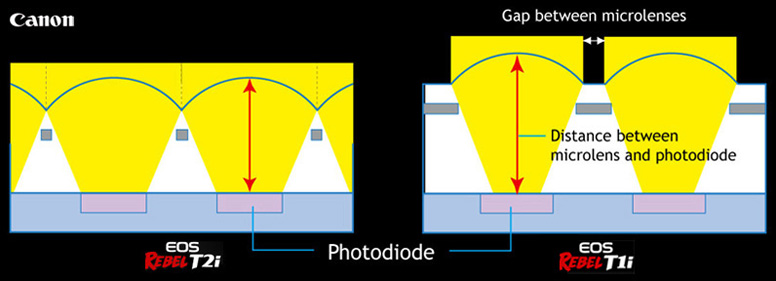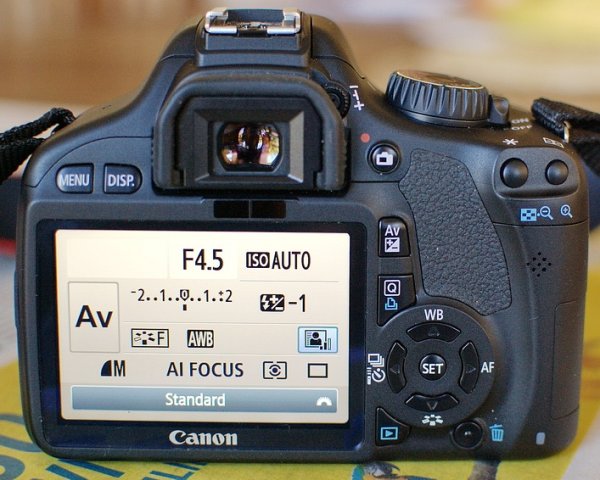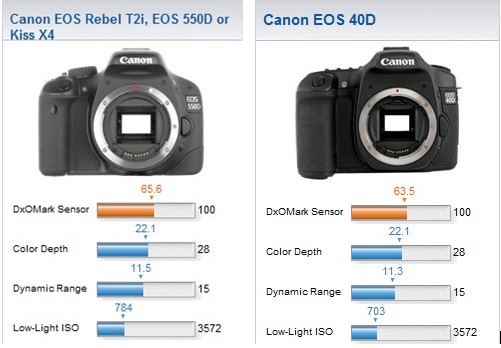Canon 2Ti/550D – Shooting to Kill the Competition?

Mục lục
Background on the Canon EOS T21/550D
With entry-level DSLRs, Canon has long walked a path of gradual
development. When a new model pops out of the factory, the model it
replaces stays in the catalogue but is sold at a lower price. It’s smart
marketing.
Canon pitches the 550D at the top end of its Entry Level DSLR group,
which stacks up like this (basic kit lens, US $):
550D
$900 18mp
500D
$800 15mp
450D
$650 12mp
1000D
$550 10mp
It’s a nice, logical spread of products, more so than Nikon’s 3
models and two sensor sizes. As I said: smart marketing. Predictably,
the 550D borrows much from the 500D it one-ups. And just as predictably,
it fires a second torpedo across the bow of the good ship Nikon whose
D90 has reigned supreme in the <$1,000 DSLR market for 18 months. The
first one was the 500D, and it didn’t really connect.

Value Proposition
Canon sums it up like this: Creative control with no
compromise on quality.
The press release elaborates: ‘The EOS 550D
redefines the boundaries of Canon’s consumer DSLR range,
incorporating technologies and features more commonly found in
semi-professional DSLRs into the compact, lightweight body favoured by
consumers. With a newly-developed 18 Megapixel (MP) APS-C CMOS sensor,
coupled with Canon’s advanced DIGIC 4 image processor and the ability to
shoot Full HD movies, photography enthusiasts are empowered to explore
new levels of creativity.’
What Canon did was to reach into the parts bin and put the 18mp
sensor from its semi-pro 7D (with a couple of corners cut) into an
entry-level body. Other features that come with the 7D sensor is an ISO
range of 100 – 6400, 14-bit image processing for smoother tonal
gradation and advanced iFCL exposure metering with 63-zone dual-layer
sensor. And the cherry on the grapefruit: full HD video recording with
selectable frame rates, manual control and support for an external
stereo microphone.
Amazing Results, No Matter the Light.
It’s a bold claim, as we’ll see. First, I
have a simple question: who needs 18 megapixels in an entry level
camera? Processing RAW images from a sensor that big on an ordinary PC
is arduous task. Files are 25 – 30 mb each. The obvious answer is that
Canon thinks that more pixels is what most of us want. Are we that
gullible? I think it’s more likely boys with their toys stuff, Canon
flexing its technology muscles at Nikon, ‘look at me, look at me …’
Sense and Sensors
Canon says its new gapless microlens design made it possible to raise
the pixel count to 18mp while also raising the 550D’s high ISO
capacity. The pixel density is 5.5MP / cm² compared to the Nikon D90’s
3.3MP / cm², and the Canon sensor has a smaller area as well (328 vs
370mm). The 550D sensor isn’t in quite up there with Nikon’s in DxOMark
ratings http://www.dxomark.com/index.php/eng/Image-Quality-Database
but it isn’t that far behind, so there’s some truth in Canon’s PR.
 Source: Canon
Source: Canon
Canon EOS T21/550D Build Quality and Handling
So the 550D is a 7D without the fast burst mode, the tough body and
the dust sealing, but it’s well-enough built with polycarbonate over a
stainless steel frame. The body is compact, no bigger or heavier than
the Pentax K-x I tested last month, and just as black. The matt plastic
looks classy and the camera feels good in the hand. Rubberised patches
on the handgrip front and back make sure your fingers don’t slip. The
bright 3” 3:2 format LCD monitor with 1 million dot resolution is a
beauty.
The test camera came with the 18-135mm f/3.5-5.6 zoom lens, which
looks more plasticky than its $500 price tag suggests. It’s also 50%
longer than equivalent lenses from other makers, and a bit bulky for a
walkabout lens. Worse, the inner tube droops when you walk about, at
least on this sample. It doesn’t have a USM AF motor and, at 50mm, f/5
is as open as it gets so it’s not that fast across the zoom range.
Menus and Modes
The layout of basic controls is pretty logical. The main differences
from the Pentax or Nikon layouts are:
- an on-off button next to the mode dial
- an upright wheel for changing shutter speed, aperture and so on
- A dedicated ISO button between the wheel and the mode dial
- A Quickview button for quick access to the main settings
Navigation is pretty straightforward but I’m puzzled by the Quick
View button. It gives you quick access to settings like flash
compensation, white balance correction and image quality, but it also
covers ISO setting, exposure control, focus mode, white balance and
picture style, settings which already have dedicated buttons on the
4-way control and the camera body. Canon could’ve provided access to
other functions instead.

Viewfinder
The Canon EOS T21/550D’s viewfinder feels a touch cramped next to the
Nikon D90’s but looks generous compared to the D5000. It covers 95% of
the scene with 0.87x magnification, and it’s bright with very clear
numbers on the bottom row. The penta-prism of the Nikon D90 is an
advantage when composing shots carefully and focusing manually, but I
have a feeling that this isn’t the kind of shooter the 550D is aimed at.
Creative Options
That becomes obvious when you probe more deeply into the treasure
chest of facilities. Alongside the usual PASM and scene modes, we have
CA and A-DEP modes. CA stands for Creative Auto, which lets you adjust
an on-screen slider to choose how much blur you want in the background
of your subject. A second slider lets you adjust exposure compensation.
The touch-screen style composition makes getting the desired
depth-of-field a doddle, while the A-DEP option simply adjusts the
aperture in the opposite direction so that everything in the photo is
sharp from front to back.
The CA mode also gives you quick access to the 550D’s image effects,
like smooth skin tones for portraits or vivid blues and greens that will
spice up landscape shots. Again, these picture styles have a dedicated
button on the 4-way control. For adjusting contrast, saturation, colour
tone within these styles, a trip to the menu is required.
Canon Can
Options for more demanding users include Auto Exposure Bracketing and
White Balance Auto Bracketing. Canon also adds Auto Lighting Optimiser,
Highlight Tone Priority and Lens Peripheral Illumination Correction,
which work their magic on photos to fix any blemishes before they come
out of the camera. Canon is pushing technology hard and here is the
low-down on ‘how-do-we-do-it?’ http://www.usa.canon.com/consumer/controller?act=MultiMiscPageAct&key=EOS_Advantage_IQ&fcategoryid=139
Performance
The proof is in the eating, they say, and lovely photos came out of
the 550D from the moment I started shooting. I was struck by colours
that are very accurately rendered and excellent sharpness, from
close-ups to landscapes. This is clearly a competent camera, with fast
autofocus, crisp shutter action, spot-on metering in most situations and
natural transitions in high contrast scenes. This is an easy camera to
use and to like. It even cleans the sensor for you every time you turn
it off.
(click on image to see full size)
The lens turns out to be very capable of resolving all the detail the
18mp sensor collects. Canon claims that the Image Stabilisation built
into this lens provides four f-stops of shutter speed advantage. That’s a
big claim and I have enough shaky shots to make me doubt it, but then
again it could be me.
The only real stumbling block was RAW – none of my RAW converters had
yet learned about the new Canon 550D files, which meant I had to
install the one Canon supplied with the camera. In the end I decided I
didn’t really need to learn yet another RAW converter. Also, the RAW +
JPEG files I shot were around 30mb in size, which is ridiculous for
anything but professional purposes IMHO. Therefore I settled on the
finer of the two 8mp JPEG settings on the menu. The shots were as sharp
as ever, and a lot more manageable.
Low-light Shooting
I’d looked forward to testing the 550D in poor light, and it is
competent here if not as good as Canon claims. Shots taken at 1600 are
clean, shots taken at ISO 3200 are acceptable but I’d leave 6400 for
emergencies and forget about 12,800. This one was shot at ISO 3200.

I’ve put more high ISO shots (and others) in the 550D photo gallery
on my blog http://briard.typepad.com/get_the_picture/canon-eos-550d-gallery.html
The low-light performance of the 550D is comparable to that of the
Pentax K-x and Nikon D90/D5000. Nikon has a slight edge in DxOMark
performance but that’s less obvious in the real world.
The Canon has a slight edge in colour rendering, to my eye at least.
On the ‘Faithful’ setting (don’t you love it?), the D550 does a minimum
of in-camera processing and the colours that come out of it are very
natural.
Live View and Movie modes
The same button next to the viewfinder activates either, depending on
the mode dial. Live View has the same problems with slow focus as its
competitors, and an articulated screen would be nice to have for both
these functions. Canon puts those screens on digicams, so it’s hard to
understand why it’s missing here especially for video capture. The
550D’s video is now true HD format, has user selectable frame rates and
provides control over apertures and shutter speeds.
Using it is easy as pie: Switch to movie mode, focus and press the
liveview/movie button to start recording video. Pressing the shutter
button while you are recording a video will stop the video and record a
stills image. Check this site for some examples http://www.outbackphoto.com/CONTENT_2007_01/section_gear_cameras_2010/20100306_Canon_550D/index.html
Image Quality
On the whole, the 550D’s image quality is excellent, and it’s
comparable to the Nikon D90’s output while providing much more
resolution. I’m not sure what the average user would do with that much
of a good thing, and I find the 18 megapixel sensor puzzling given
Canon’s bold turnaround with their recent digicams.
18 months ago, Canon was leading the megapixel charge with the G10,
which boasted 15mp. Then late last year, the G11 and S90 surprised the
market with a 10mp sensor. Less of a surprise was that these cameras
delivered improved image quality, less noise and better low light
performance. So how come Canon’s DSLR division didn’t follow the same
logic?
The DxOMark data show that, despite all that new technology, the 550D
is not that far ahead of the 3-year old 10mp 40D. That makes me wonder
if Canon couldn’t have produced a D90-beating sensor if it’d settled for
12 megapixels. Or 10.

Verdict
Does Canon have a winner? Yes. The market Canon is targeting with the
Rebel T2i / EOS 550D is the buyer who wants quality equipment but
doesn’t get carried away with the finer points and the creative
possibilities they offer. Think of this camera as a serious
point-and-shoot machine with a lot of clever automation. This isn’t
meant as a put down to 550D buyers – I suspect a lot of sub-thousand
dollar DSLRs are used in Auto mode these days, with a single 18–200 lens
on the front.
The upside is that cameras like this make it easier for more people
to take better photos, the downside is that refinements like those
served up by the 550D will do away with the need to learn the basic
principles of photography. Sure, you could argue that that’s been
happening since the Kodak Instamatic saw the light of day.
The reality is that the DSLR market is under pressure from pumped-up
digicams, and DSLR vendors have to make their low-end models more
feature-rich yet easier to use. Nikon is heading the same way as Canon
with the D3000 and D5000.
For advanced users who buy the 550D for what it is capable of, Canon
has provided more than enough control, so the camera can serve two
different masters. In other words, a keen shooter and a partner who’s an
occasional shooter can happily share the same camera. The 550D really
is as easy as you want to make it. I find some of the operational
duplication distracting but others might see extra convenience in it.
Competition
Canon EOS 550D vs Nikon D90
The Nikon D90 is due for a major upgrade or replacement later this
year. Right now, the 550D has more pixels, more automated shooting
options for novices, 14-bit colour processing, a higher on-paper ISO
option (12,800 vs 6,400), better live-view and better video facilities.
The Nikon D90 has the better viewfinder, better sensor, slightly
better ergonomics, an LCD on top of the body, and Active D-Lighting said
to more effective than Canon’s Lighting Optimiser. If you’re not a
novice and mainly shoot stills, the decision will be tough but the Nikon
may win. If you shoot a lot of video, then the Canon will be it.
Canon EOS 550D vs the rest
The 550D and D90 are about the same price – $900. You could save $150
and settle for a Nikon D5000. You’d lose the big penta-mirror
viewfinder but keep the D90 sensor and gain an articulated screen. Or
you can save nearly $300 and buy a Pentax K-x, which uses the same
sensor as the D90 (I’m told), is well-built, comes loaded with features
but misses out on a few conveniences.
You could also opt for the cheaper Canon 500D. If you already own
one, the 550D probably doesn’t have enough extras to make you want to
change over. In fact, the 550D is being squeezed by siblings on both
sides. The price of the semi-professional 50D has dropped to – you
guessed it – $900 (body only). It’s an older model but comes with a
magnesium alloy shell, a bigger penta-prism viewfinder, 6.3fps
continuous shooting, an upper LCD information screen and more. What the
50D doesn’t have is video of any kind.
Summary
The competitive picture above is merely a snapshot in time. The
current $900 price tag for the 550D may seem a bit steep but the street
price will drop over time. It’s not surprising that the 50D has dropped
so much since it’s about to be replaced, and it’s telling that the Nikon
D90 price has held rock-steady for 18 months. Nikon may not be in such a
hurry to replace it but, when it does, you can rest assured that Canon
will have a countermove already in the pipeline. These two companies
watch each other like hawks. Meanwhile, the EOS 550D is a highly
competent and desirable camera.
A word on my methodology
I don’t test or review cameras the way DP Review or Steve’s Digicams
do. I test cameras as a user, and that means I look for good design,
ease of use and logical operation and navigation. Good design is about a
great user experience, something very few companies are good at. Here’s
a piece of my mind on the subject http://www.technoledge.com.au/pdfs/user-experience.pdf
Additional Resources
If you want all the gory details, look no further than DPReview
http://www.dpreview.com/reviews/canoneos550d/page29.asp
http://www.cameralabs.com/reviews/Canon_EOS_550D_Rebel_T2i/noise_JPEG.shtml
http://www.dcresource.com/reviews/canon/eos_rebel_t2i-review
Kim






